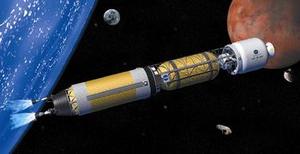Nuclear powerNuclear-powered deep space rockets
In the 1960s the federal government tested nuclear rocket technology for the flights following the Apollo moonshots. The Los Alamos National Laboratory in New Mexico set up Project NERVA (Nuclear Energy for Rocket Vehicle Application). The concept was to use a nuclear reactor to blast a rocket out of Earth’s orbit. Concerns about safety and cost put an end to the project in 1973, but now there are some it is time to revisit the concept of nuclear rockets for deep space exploration.

Artist's rendering of a Nuclear Thermal Rocket // Source: nasa.gov
In the 1960s the federal government tested nuclear rocket technology for the flights following the Apollo moonshots. The Los Alamos National Laboratory in New Mexico set up Project NERVA (Nuclear Energy for Rocket Vehicle Application). The concept was to use a nuclear reactor to blast a rocket out of Earth’s orbit. The initial plan was for NERVA technology to power the first manned mission to Mars in the early 1980s, and more than twenty rockets were tested, but concerns and the costs and nuclear power led to the project being cancelled in 1973, and the space shuttle program was started.
NBC reports that the idea for nuclear rocket propulsion was brought up again briefly in 2003 as NASA considered building a reactor -based system for deep-space missions such as the Jupiter Icy Moon Orbiter, as part of what is known as project Prometheus.
The idea was for a small reactor to create electricity for an ion drive, instead of re-creating the NERVA concept. As was the case with NERVA, however, the Prometheus plan was deemed too complex and expensive and was axed in 2005.
Now, the White House has received a petition to build a nuclear rocket for fast interplanetary travel. Aaron VanAlstine, an army major at Joint Base Lewis-McChord just outside of Seattle, created the petition and sent it through the White House’s “We the People” program urging the government to “rapidly develop and deploy a nuclear thermal rocket.”
“Harness the full intellectual and industrial strength of our universities, national laboratories and private enterprise to rapidly develop and deploy a nuclear thermal rocket (NTR) adaptable to both manned and un-manned space missions. A NTR (which would only operate in outer space) will jump-start our manned space exploration program by reducing inner solar system flight times from months to weeks. This is not new technology; NTRs were tested in the 1960s (President Kennedy was a guest at one test). The physics and engineering are sound. In addition to inspiring young Americans to careers in science, technology, engineering and mathematics, a working NTR will herald a speedy and economical expansion of the human presence in the cosmos.”
For VanAlstine, his petition is not about now, but about the future of space exploration. “It’s not me that’s going to go into space,” VanAlstine, who turns 49 this week, told NBC News. “But maybe my nephew will be riding this.”
In order for the petition to receive a response from the White House, it will need 25,000 online supporters by 2 February. ValAlstine came up with the idea after hearing about another “We the People” petition that criticized Piers Morgan, a CNN Talk-show host.
“I thought, well, what can I do to get something started?” ValAlstine told NBC News. “I don’t have anything to do with the aerospace industry,” VanAlstine added. “I’m just into space.
“A lot of the scientists say the only way to get enough mass up and get the travel time down is to go with NTR,” VanAlstine said. “I’m not an engineer or anything, but that’s what all the smart guys are saying. … It’s never going to be like ‘2001’ without going with the nuclear thermal rocket.”
At this time NASA is working to develop an Orion exploration spaceship and a heavy-lift rocket capable of sending humans beyond Earth orbit by 2020. The program could cost up to $35 billion.
